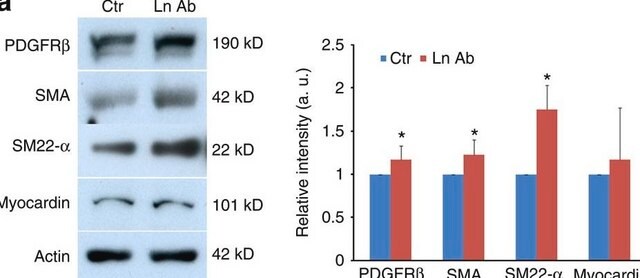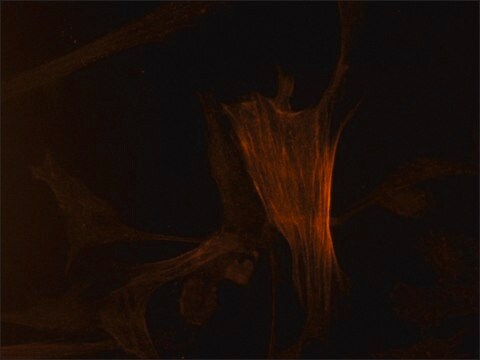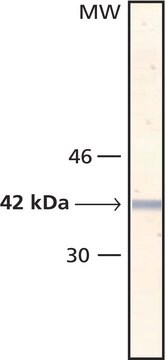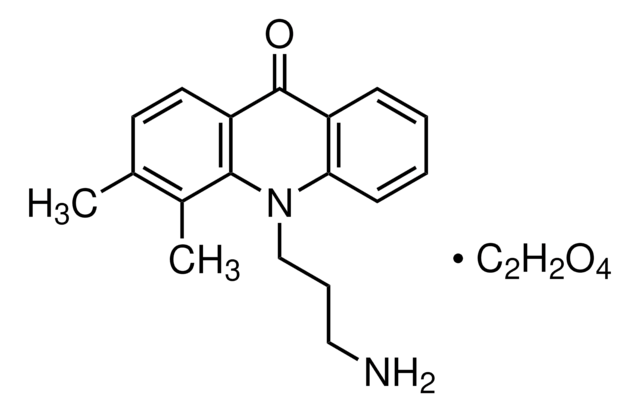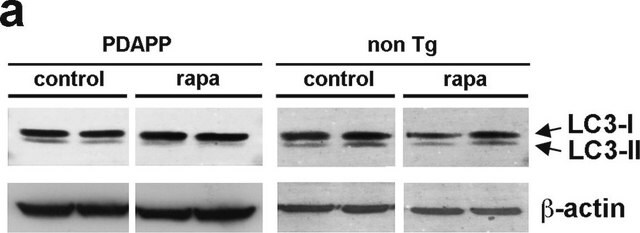F3046
Monoclonal Anti-Actin–FITC antibody produced in mouse
clone AC-40, purified immunoglobulin, buffered aqueous solution
Sinonimo/i:
Monoclonal Anti-Actin
About This Item
Prodotti consigliati
Origine biologica
mouse
Livello qualitativo
Coniugato
FITC conjugate
Forma dell’anticorpo
purified immunoglobulin
Tipo di anticorpo
primary antibodies
Clone
AC-40, monoclonal
Forma fisica
buffered aqueous solution
PM
antigen 42 kDa
Reattività contro le specie
human, Xenopus, hamster, mouse, guinea pig, rat, rabbit, snail, sheep, canine, carp, chicken, pig, bovine, viper, goat
tecniche
direct immunofluorescence: 1:75 using cultured human or chicken fibroblasts
Isotipo
IgG2a
Condizioni di spedizione
dry ice
Temperatura di conservazione
−20°C
modifica post-traduzionali bersaglio
unmodified
Informazioni sul gene
human ... ACTA1(58) , ACTA1(58) , ACTA1(58) , ACTA2(59) , ACTA2(59) , ACTA2(59) , ACTB(60) , ACTB(60) , ACTB(60) , ACTC1(70) , ACTC1(70) , ACTC1(70) , ACTG1(71) , ACTG1(71) , ACTG1(71) , ACTG2(72) , ACTG2(72) , ACTG2(72)
mouse ... Acta1(11459) , Acta1(11459) , Acta1(11459) , Acta2(11475) , Acta2(11475) , Acta2(11475) , Actb(11461) , Actb(11461) , Actb(11461) , Actc1(11464) , Actc1(11464) , Actc1(11464) , Actg1(11465) , Actg1(11465) , Actg1(11465) , Actg2(11468) , Actg2(11468) , Actg2(11468)
rat ... Acta1(29437) , Acta1(29437) , Acta1(29437) , Acta2(81633) , Acta2(81633) , Acta2(81633) , Actb(81822) , Actb(81822) , Actb(81822) , Actc1(29275) , Actc1(29275) , Actc1(29275) , Actg1(287876) , Actg1(287876) , Actg1(287876) , Actg2(25365) , Actg2(25365) , Actg2(25365)
Cerchi prodotti simili? Visita Guida al confronto tra prodotti
Descrizione generale
Immunogeno
Applicazioni
Azioni biochim/fisiol
Stato fisico
Altre note
Esclusione di responsabilità
Non trovi il prodotto giusto?
Prova il nostro Motore di ricerca dei prodotti.
Codice della classe di stoccaggio
12 - Non Combustible Liquids
Classe di pericolosità dell'acqua (WGK)
nwg
Punto d’infiammabilità (°F)
Not applicable
Punto d’infiammabilità (°C)
Not applicable
Certificati d'analisi (COA)
Cerca il Certificati d'analisi (COA) digitando il numero di lotto/batch corrispondente. I numeri di lotto o di batch sono stampati sull'etichetta dei prodotti dopo la parola ‘Lotto’ o ‘Batch’.
Possiedi già questo prodotto?
I documenti relativi ai prodotti acquistati recentemente sono disponibili nell’Archivio dei documenti.
Il team dei nostri ricercatori vanta grande esperienza in tutte le aree della ricerca quali Life Science, scienza dei materiali, sintesi chimica, cromatografia, discipline analitiche, ecc..
Contatta l'Assistenza Tecnica.